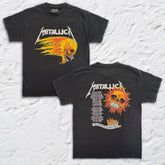Could metal help us save the world?
IS METAL MUSIC GOOD FOR YOU? - LET'S FIND OUT
In the minds of the uninitiated, metal music-especially death metal and grindcore-sounds like a melody written by an angry caveman. Metal has always been brash. But as with the concept of caveman itself, research has built up a much more nuanced picture of the genre. Scholars and fans alike are now exploring its role in emotional regulation.
What makes a song metal?
Metal emerged as a genre distinct from rock in the early 1970s. A particular mix of driving drum-and-bass rhythms, distortion, and exaggerated vocal styles sets it apart from punk. According to guitarist Zett, metal has to have distorted guitars and riffs, and it has to be loud and crunchy. But even those qualities don’t quite get to the heart of the matter, because metal contains multitudes.
THE ANATOMY OF A METAL LOGO A logo does more than just tell you the name of a band. With subtle (or not-so-subtle) design choices, they can also tell a savvy metalhead what the music will sound like. Could metal help us save the world? , For black metal insignias, illegibility is part of the point. The chaotic tendrils, left-right symmetry, and black-white color scheme all let you know that distorted tremolo-picked guitars are on offer. For thrash, they frequently feature blocky, pointy letters and garish color schemes favoring acid green, purple, red, and yellow.

Metalheads aren’t who you think they are
145 of the world's nations had at least one active metal band in 2021, and metal fans are more diverse than you might assume. Author Laina Dawes argues that punk, power violence, grindcore, and other genres are known to be explicitly political and may offer a form of catharsis for youths dealing with individual and systemic oppressions.
WHERE THINGS GET HEAVY Which countries are the most metal? The culture appears to flourish in countries with relatively high wealth and, especially in the time before the internet, in fairly isolated ones—where musicians often play in multiple bands at once. Data via Encyclopaedia Metallum + The Metal Map
In the '70s through the early '90s, rap met a need for raw production with unsparing dissections of race and poverty. Dawes' research suggests that modern tracks, with their slick audio engineering and wider lyrical focus, don't offer the same release. "These days heavy metal might be a better genre to get involved in," she adds.

OK, metal is intense. But is it bad for you?
Despite growing evidence, the stereotype of brooding and violent metal fans pervades. Because of this, researchers across disciplines have paid plenty of attention to how this music might mold minds. They've looked at metalhead personality traits, questioned their propensity for self-harm and violence, and even tutted over the risks of headbanging-related brain injuries.
THE RIGHT WAY TO HEADBANG
It is possible to headbang (relatively) safely. If your head moves more than 90 degrees with each bang, you're in brain injury territory. Speeds below 110 beats per minute help avoid strain, especially with the arc of each movement at 45 degrees or less. In 2010, headbangers were drawn to theatricality, a preference they shared with classical aficionados.
But that’s not to say that metal doesn’t affect us. A 2015 study surveyed 377 people who were metalheads in the ’80s. While they often engaged in risky “sex, drugs, and rock-and-roll†habits as youths, they were also significantly happier during that time than their peers—and better adjusted as adults. It could be that being on the cultural fringes can help one develop a strong sense of self, and perhaps even help build supportive friendships.

THE MADDING CROWD In 2013, physicists at Cornell studied concert crowd dynamics to better understand how they devolve into full-contact chaos. The mosh pit is but one of several potential outcomes. Here are three of the most common configurations:
Mosh pit (left): Moshers behave quite a bit like an ideal gas, where each person moves according to their own whim, unaffected by the motions of the people around them.
Circle pit (center): A tendency to stick together—or “flockâ€â€”triggers this well-known vortex. Instead of running through the open space at random, participants speed around the perimeter, with a few headbangers in the middle.
Wall of death (right): Cornell’s study didn’t model this phenomenon, but every metalhead knows it. When the song kicks in, members of the crowd, separated in two on opposite ends of the room, run toward one another. You don’t need a simulation to guess the result: absolute carnage. Kyle Hilton; data from Silverberg et al. 2013
A 2015 study from the University of Queensland, Brisbane assessed how extreme music affected anger processing. Researchers first subjected 39 metalheads to "anger induction" by strategically prompting them to recall incidents that had made them mad. Participants reported feeling positive and "inspired" during and after the metal sesh. Authors posit that intense music could provide an outlet for tough feelings rather than be their genesis.

So can metal save the world?
When you accept that metal builds communities, it follows that headbanging could help us survive tough times, including, one scientist argues, the impending climate apocalypse. Maintaining mental and emotional resilience will be key to both surviving the upheaval and building a stronger future, David Angeles argues. "We need to return to the era of Romanticism, where different fields, such as the arts and sciences, are not mutually exclusive."
WHAT’S IN A SONG? OK, fair: Death is metal’s most common lyrical theme. But this analysis of modern subgenres shows that songs address a huge range of topics, including some of life’s most profound and universal struggles. Data courtesy of Evan Chabot, UCF
Metal bands are focusing their lyrics on topics like climate change, biodiversity loss, and environmental collapse. Sustainability specialists could use the music to turn their studies into areas that address those problems. Metal's rich sound structures could prove ideal for creating artistic representations of complex problems. One could elicit harmonic and empowering feelings through symphonic metal while conveying chaos with mathcore or despair in doom tracks.

Could other kinds of music also provide this benefit? Sure. But metal's willingness to address ugly truths, its penchant for transforming distress into emotional resilience, and its ability to create community all across the world make it a model for how art can continue to give us meaning even when things around us are falling apart.
This story originally ran in the Summer 2022 Metal issue of PopSci. Read more PopSci+ stories.











